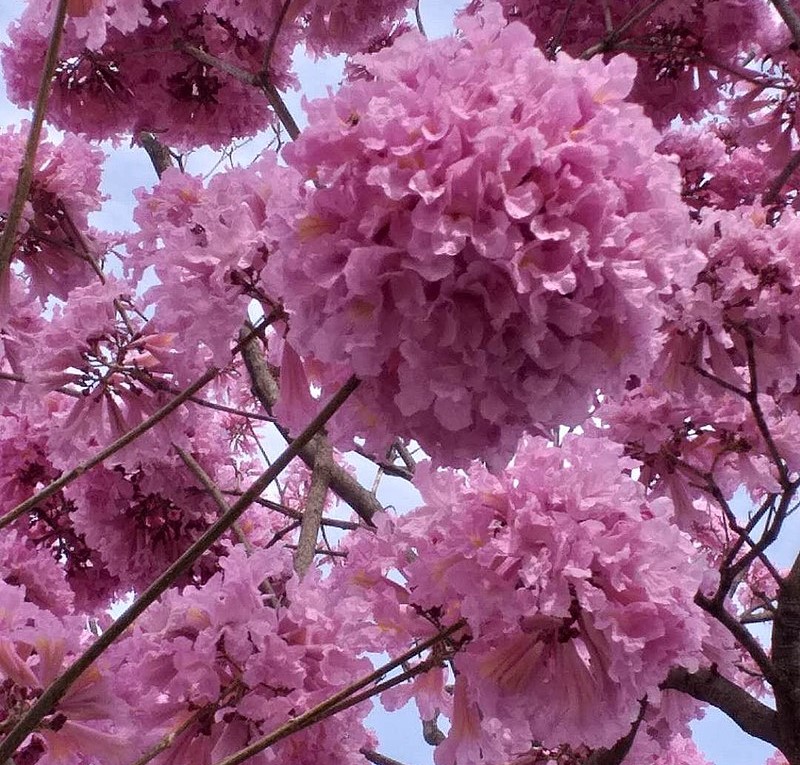Tabebuia Rosea

|
|
Tabebuia rosea Common Names: Pink trumpet tree, Rosy trumpet tree,
Savannah oak, White cedar Scientific
Classification Kingdom: Plantae Clade: Tracheophytes Clade: Angiosperms Clade: Eudicots Clade: Asterids Order: Lamiales Family: Bignoniaceae Genus: Tabebuia Species: T. rosea Synonyms: Tecoma rosea Bertol., Tabebuia pentaphylla (L.) Hemsl., Sparattosperma roseum (Bertol.) Miers, Couralia rosea (Bertol.) Donn.Sm. Morphological Description Tabebuia rosea is
a medium to large deciduous tree, typically 15–30 meters tall, with a straight
bole up to 1 meter in diameter. Its key characteristics include: · Bark: Grey to brown, vertically fissured with corky ridges; used
medicinally for its bioactive compounds (Burkill, 1985). · Leaves: Palmately compound, with 3–5 elliptic to oblong leaflets
(8–35 cm × 3–18 cm), acute to acuminate apex, glabrous; petioles 5–32 cm long
(Prance & Jongkind, 2015). · Flowers: Large, trumpet-shaped, pink to purple (5–8 cm long), in
terminal clusters; bloom when leafless, creating a striking display (Fern,
2024). · Fruit: Linear capsules (10–35 cm × 1–2 cm), green turning brown,
containing numerous winged seeds (2–3 cm long) (Kew Science, n.d.). Distribution and Habitat Tabebuia rosea is
native to Central and South America and widely introduced in tropical regions: · Geographic Range: Native from southern Mexico to Venezuela
and Ecuador; introduced to West Africa (Nigeria, Ghana), Asia (India,
Malaysia), and the Caribbean; cultivated in Nigeria for ornamental and
medicinal purposes (Kew Science, n.d.). · Habitat: Thrives in moist to dry forests, open fields, and along
roadsides; prefers well-drained, loamy soils (pH 5.5–7.0) with annual rainfall
of 800–2,000 mm; occurs at elevations up to 1,200 m (Fern, 2024). · Ecological Role: Acts as a pioneer species in disturbed
areas; supports pollinators like bees and butterflies; seeds are wind-dispersed
(Burkill, 1985). Ethnopharmacology Tabebuia rosea is
extensively used in West African and Latin American traditional medicine, with
pharmacological studies validating several applications: · Wound Healing: In Nigeria, stem bark decoctions promote wound healing.
Methanolic stem bark extracts (5% w/w in petroleum jelly) significantly reduced
excision wound size in rats by day 16, comparable to Cicatrin powder, due to
flavonoids and tannins (Nwonu et al., 2011). · Antioxidant: In Ghana, leaf extracts combat oxidative stress. · Antibacterial: In Nigeria, leaf extracts treat infections. · Anti-inflammatory: In Cameroon, bark extracts reduce
swelling. Ethanol bark extracts activated the Keap1-Nrf2 pathway, reducing
inflammation in cellular models, attributed to specioside and phenolic
compounds (Garzón-Castaño et al., 2020). · Hepatoprotective: In Nigeria, stem bark treats liver
disorders. Methanolic stem bark extracts (200 mg/kg) reduced
paracetamol-induced liver damage in rats, lowering ALT and AST levels,
comparable to silymarin (Hemamalini et al., 2012). · Antimalarial: In Ghana, bark decoctions treat malaria. Lapachol in the
bark showed antimalarial activity against Plasmodium falciparum in vitro, though its clinical use is
limited by toxicity (Castellanos et al., 2009). · Anticancer: In Nigeria, leaf extracts are used for tumors. Total
alkaloid leaf extracts exhibited cytotoxicity against MOLT-4 leukemia cells in
vitro, suggesting potential anticancer activity, though further isolation is
needed (Sathiya & Muthuchelian, 2010). ⚠ Toxicity Profile: Tabebuia rosea is generally safe at therapeutic doses,
but lapachol in the bark is associated with toxicity. Acute toxicity studies
showed no mortality in rats at methanolic bark extract doses up to 2,154 mg/kg
(LD₅₀). Sub-chronic dosing (400 mg/kg for 28 days) caused mild liver enzyme
elevation (ALT increased by 10%). Lapachol has shown reproductive toxicity and
embryolethality in animal studies, limiting its clinical use. High doses
(>1,000 mg/kg) may cause gastrointestinal distress. Use is contraindicated
in pregnancy and for children due to insufficient safety data. Potential heavy
metal contamination in wild-harvested plants requires caution (Castellanos et
al., 2009; Nwonu et al., 2011). Phytochemistry The bioactivity of Tabebuia rosea is driven by its diverse chemical constituents
· Naphthoquinones: Lapachol, α-lapachone, with antimalarial
and antibacterial effects (Castellanos et al., 2009). · Flavonoids: Quercetin, luteolin, contributing to antioxidant and
anti-inflammatory activities (Garzón-Castaño et al., 2020). · Phenolic Acids: Gallic acid, chlorogenic acid, enhancing
wound healing and antimicrobial properties (Nwonu et al., 2011). · Alkaloids: Present in leaves, with cytotoxic effects against leukemia
cells (Sathiya & Muthuchelian, 2010). · Tannins: Found in bark, supporting astringent and hepatoprotective
effects (Hemamalini et al., 2012). Additional Uses · Ornamental: Planted in Nigeria for its vibrant pink flowers, enhancing
urban landscapes and parks (Fern, 2024). · Timber: Durable wood used in Nigeria for construction, furniture,
and tool handles (Burkill, 1985). · Ecological: Used in reforestation to stabilize soils; supports
biodiversity by attracting pollinators (Fern, 2024). · Cultural: In Yoruba culture, bark decoctions are used in rituals for
spiritual cleansing (Burkill, 1985). References
External Links More Pictures |
|
| Compounds of Tabebuia Rosea | |
| References |